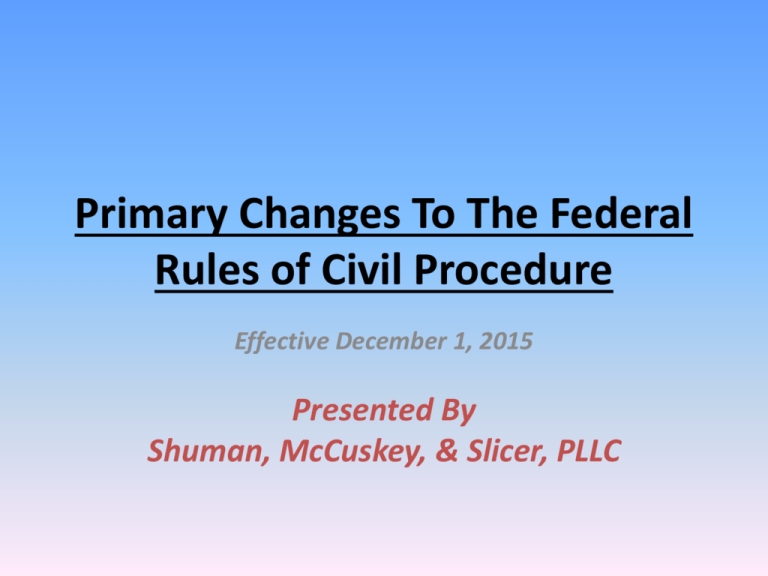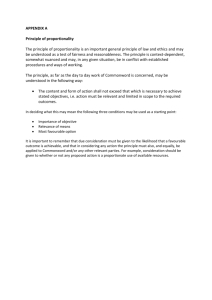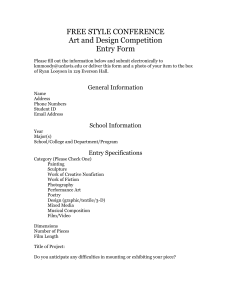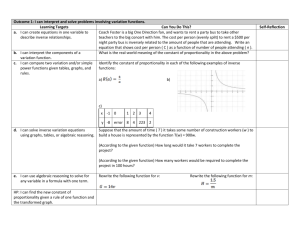Changes To The Federal Rules of Civil Procedure
advertisement

Primary Changes To The Federal Rules of Civil Procedure Effective December 1, 2015 Presented By Shuman, McCuskey, & Slicer, PLLC Rule 1 – Scope and Purpose • This rule has added language to ensure the parties’ knowledge that they and the Court are to employ these rules to secure the just, speedy, and inexpensive determination of every action and proceeding. Rule 4. Summons • This rule has adopted new forms for a request of waiver and for waiver of service by the parties which are appended to the rule itself rather than those forms formerly found in the appendix of these rules. Rule 4. Summons Continued • The time limit for service on a defendant has been reduced from 120 days to 90 days, and if a defendant is not served within 90 days after the complaint is filed, the Court — on motion or on its own after notice to the plaintiff — must dismiss the action without prejudice against that defendant or order that service be made within a specified time. • This change, together with the shortened times for issuing a scheduling order set by amended Rule 16(b)(2), will reduce delay at the beginning of litigation. • Shortening the time to serve under Rule 4(m) means that the time of the notice required by Rule 15(c)(1)(C) for relation back is also shortened. Rule 16. Pretrial Conferences; Scheduling; Management • This rule has removed the ability of Courts to consult with the parties outside of an in-person scheduling conference before the issuance of a scheduling order. Parties previously could be consulted by telephone, mail, or other means. • The judge also must issue the scheduling order as soon as practicable, but unless the judge finds good cause for delay, the judge must issue it within the earlier of 90 days after any defendant has been served with the complaint or 60 days after any defendant has appeared. This has been reduced from the lesser of 120 and 90 days, and is another 30 day reduction so as to be consistent with Rule 4 as shown before. • This Rule has also added that scheduling orders may provide for the preservation of electronically stored information, which is a new theme the rules are beginning to highlight due to its prevalence and the problems it has posed to parties and Courts. • Also, before moving for an order relating to discovery, the movant must request a conference with the Court first; Rule 26 - Discovery • The scope of discovery has taken on a new “proportionality standard” instead of the “reasonably calculated to lead to discovery of admissible evidence standard” in the past. • Now Parties may “obtain discovery regarding any non-privileged matter that is relevant to any party’s claim or defense and proportional to the needs of the case, considering the importance of the issues at stake in the action, the amount in controversy, the parties’ relative access to relevant information, the parties’ resources, the importance of the discovery in resolving the issues, and whether the burden or expense of the proposed discovery outweighs its likely benefit. Information within this scope of discovery need not be admissible in evidence to be discoverable.” • This is meant to stop over-inclusive production and requests in order to protect clients from spending too much on incredibly voluminous discovery. Parties must be conscious of the change, and use the factors of this rule to restrain overbroad discovery requests. Parties should approach issues with specificity and discuss/negotiate with the other side to agree on a scope, perhaps in a joint letter, or maybe a teleconference with the Court instead of briefing it. Rule 26 Continued – Protective Orders • Protective orders now can include an allocation of expenses for discovery; for example: who will pay for production of documents. Courts already have this power, but this codifies that ability. This can be utilized in the proportionality argument above by saying, “my requests are not overbroad because I am paying part of the cost of this discovery.” Rule 26(d) Timing and Sequence of Discovery. • Parties now may make “Early Rule 34 Requests” which are requests for production of documents. These requests can only be made 21 days after the summons and complaint are served on that party. The request is considered to have been served at the first Rule 26(f) conference. Once served, that party has 30 days to answer the request. • Also, discovery plans must now state the parties’ views and proposals on preservation of electronically stored information, along with the disclosure and discovery of that information. Rule 30. Depositions by Oral Examination • Leave to take an oral deposition now must be granted to the extent consistent with Rule 26(b)(1) and (2), thereby incorporating the new proportionality standard of discovery. • Proportionality also applies to the duration of oral depositions, where the Court must allow additional time consistent with Rule 26(b)(1) and (2) if needed to fairly examine the deponent. Rule 31. Depositions by Written Questions • Depositions by written questions must also be granted by the Court to the extent the deposition is consistent with the proportionality standard of Rule 26(b)(1). Rule 33. Interrogatories to Parties • Leave to serve additional interrogatories may be granted to the extent consistent with the proportionality standard of Rule 26(b)(1) and (2). Rule 34. Producing Documents, Electronically Stored Information, and Tangible Things, or Entering onto Land, for Inspection and Other Purposes • This rule has been changed to incorporate the times for delivery and responses to Early Rule 34 Requests under Rule 26(d)(2). The party to whom the request is directed must respond in writing within 30 days after being served or — if the request was delivered under Rule 26(d)(2) (early Rule 34 Requests) — within 30 days after the parties’ first Rule 26(f) conference. • The responding party may state that it will produce copies of documents or of electronically stored information instead of permitting inspection. The production must then be completed no later than the time for inspection specified in the request or another reasonable time specified in the response. • Also, objections to the production of documents now must state whether any responsive materials are being withheld on the basis of that objection. Rule 37. Failure to Make Disclosures or to Cooperate in Discovery; Sanctions • Rule 37 now codifies the ability of a party to compel a discovery response when a party fails to produce documents which were requested under Rule 34 (Requests for Production). *New Rule - 37(e) – Failure to Preserve Electronically Stored Information • This important new rule provides Courts the ability to impose unfavorable presumptions, unfavorable jury instructions, dismissal of the action, or default judgment against a party who fails to preserve electronic information which should have been preserved in the anticipation or conduct of litigation. • If electronically stored information is lost because a party failed to take reasonable steps to preserve it, and it cannot be restored or replaced or replaced through additional discovery, the Court may, if it finds prejudice done to the requesting party, order measures to cure the prejudice; • If the Court finds that the party acted with the intent to deprive another party of the information’s use in the litigation, the Court may presume that the lost information was unfavorable to the party; it may instruct the jury that they may or must presume the information was unfavorable to the party; or the Court may dismiss the action or enter a default judgment. Rule 55. Default; Default Judgment • This Rule now allows for the setting aside of final default judgments under Rule 60(b). Abrogation • Rule 84 – Forms – Abrogated • Appendix of Forms – Abrogated • Rule 84 and the Appendix of Forms are no longer deemed necessary and have been abrogated. The forms the Rule and the Appendix provided may be found at various sites online.






